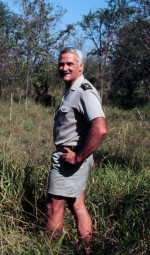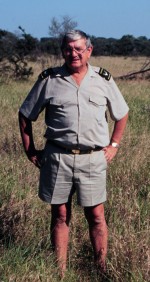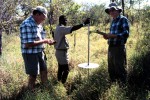A recent burst of activity among countries in southern Africa that are interested in establishing long-term research programs. Although there are only two formally constituted national networks in this region (Namibia and Zambia), several other countries are working toward establishing networks, and one (South Africa) has initiated cross-site research efforts with the Konza and Sevilleta sites. The African effort is organized under the rubric Environmental Long-Term Observatories of Southern Africa (ELTOSA), whose founding members are Namibia, Botswana, Mozambique, South Africa, Tanzania and Zambia.
Recent Visit to U.S. LTER sites
During May of 2001, representatives of all of the founding ELTOSA countries except Zambia visited U.S. LTER sites and the Network Office. Participants included Feetham Banyikwa (Tanzania), Rui Brito, Luisa Santos, and Almeida Sitoe (Mozambique), Joh Henschel (Namibia), Susan Ringrose (Botswana), and a large group from South Africa. The trip was sponsored by the Africa, Near East, and South Asia program of NSF's Division of International Programs and organized by the Network Office. After an overview of the U.S. Network presented by James Brunt in the Network Office, the group spent their first few days at Sevilleta. From there, participants in the trip dispersed to various LTER sites, with the biggest group (from South Africa) going to Konza to complete a reciprocal visit (see below).
Various participants visited Harvard Forest, Jornada Basin, Shortgrass Steppe, Kellogg Biological Station, and Virginia Coast Reserve. After their visits, the group reunited at NSF to meet with program officers and chart out the future of the southern Africa LTER programs. Bob Waide represented the U.S. LTER at that meeting, at which the concept of ELTOSA was born.
Cross-site ILTER study on grassland fire
A cross-site international study is being developed among the Konza Prairie and Sevilleta LTER sites and Kruger National Park in the Republic of South Africa. Fire ecology in the grasslands of these sites is the study theme, taking advantage of ongoing fire research programs in the African savanna, the tall grass prairie of Kansas, and the desert grasslands of New Mexico.
In April 2000, eight ecologists from Kansas and New Mexico visited Kruger National Park, supported by NSF's International Program. Alan Knapp, Dave Hartnick, Melinda Smith and John Blair (Konza Prairie LTER), along with Bob Parmenter, Mike Friggens, Dave Lightfoot and Tim Lowrey (Sevilleta LTER), worked with South African ecologists to collect preliminary data on plant biomass, nutrient content, and rodent and grasshopper populations on a series of Kruger NP sites that had undergone 50 years of experimental fire regimes. A day-long symposium on fire ecology studies of the various sites was held at the Skukuza Conference Center in Kruger NP.
In May 2001, South African scientists visited the Sevilleta, Jornada and Konza LTER sites. Dr. Harry Biggs, Dr. Rina Grant, Dr. Tony Palmer, Dr. Andrew Deacon, Prof. Winston Trollope, Andre Potgieter, Andries Bronn, Anthony Mills, Size Nibe, and Nick Zambatis constituted the South African delegation. Two fire symposia were held (one each at Sevilleta and Konza), and the ecologists participated in numerous field trips to the respective field research sites.
The results of these exchange visits are leading to a formal cross-site research collaboration, being directed by Alan Knapp (Konza Prairie LTER) and Harry Biggs (Kruger NP). Plans are underway for a second LTER-group visit to Kruger to select study sites and continue collecting preliminary data for the project.

 Enlarge this image
Enlarge this image


